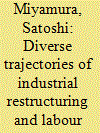| Srl | Item |
| 1 |
ID:
160858


|
|
|
|
|
| Summary/Abstract |
Previous studies have investigated whether Chinese exports have crowded out those from other countries. However, what has yet to be considered is the evidence based on different quality varieties. Using the most detailed Harmonized System 9‐digit product‐level data, the present paper provides evidence of crowding‐out and crowded‐out effects across different product quality segments and across manufacturing sectors by quality segments. The empirical evidence presented in this paper shows that the crowding‐out effects of Chinese exports have been greatest at the lower end of the quality spectrum but less significant at the higher quality spectrum. Moreover, since 2007, China's own exports of lower quality manufactured goods have been increasingly crowded out. The key policy implication is that China's export path is in line with that taken by other Asian economies in previous decades; the crowded‐out effect could achieve win–win outcomes for countries involved; and lower income countries would do well to be open to receive those relocated low value‐added industries from China. However, the relocation policy in China is best implemented gradually as climbing up the product quality ladder takes time.
|
|
|
|
|
|
|
|
|
|
|
|
|
|
|
|
| 2 |
ID:
148276


|
|
|
|
|
| Summary/Abstract |
It is often claimed that industrial restructuring leads to diminished roles for trade unionism and other forms of labour organisations by informalising employment and relocating production. Drawing on selected case studies from long-term fieldwork in regions of India, this article shows that trajectories of industrial restructuring and the responses by organised labour over the past two decades have been diverse. It is argued that the diverse response not only reflects structural opportunities and constraints for labour to be organised in particular ways, but also different histories and experiences of labour association. Contrary to the presumption about the general demise of trade unionism and the apparent unattainability of class solidarity in contemporary globalised capitalism, it is observed that India’s labour movement is experiencing a degree of resurgence, and new forms of labour organisations and activism are emerging, especially involving informal workers in the formal sector. That these innovative forms of mobilisation are shaped by experiences and aspirations that do not conform to the established institutionalised frameworks for dispute resolution has important policy and political implications.
|
|
|
|
|
|
|
|
|
|
|
|
|
|
|
|
| 3 |
ID:
104977


|
|
|
|
|
| Publication |
2011.
|
| Summary/Abstract |
With economic development and the change of industrial structure, industrial relocation is an inevitable trend. In the process of industrial relocation, environmental externality and social cost could occur due to market failure and government failure. Little attention has been paid to this issue. In this paper, we address it with a theoretical analysis and an empirical investigation on the relationship between China's industrial relocation in the early 1990s and energy consumption which is the primary source of CO2 emission, an environmental externality that causes increasing concerns. The macro-policy analysis suggests that there would be a positive link between China's industrial relocation in the early 1990s and energy saving (and environmental externalities reduction). Using fixed-effect regression model and simulation method, we provide an empirical support to this argument. In order to further reduce environmental externalities and social cost in the process of industrial relocation, we provide policy suggestions as follows: First, strengthen the evaluation of environmental benefits/costs; Second, pay more attention to the coordinated social-economic development; Third, avoid long-lived investment in high-carbon infrastructure in areas with industries moved in; Fourth, address employment issue in the areas with industries moved out.
|
|
|
|
|
|
|
|
|
|
|
|
|
|
|
|